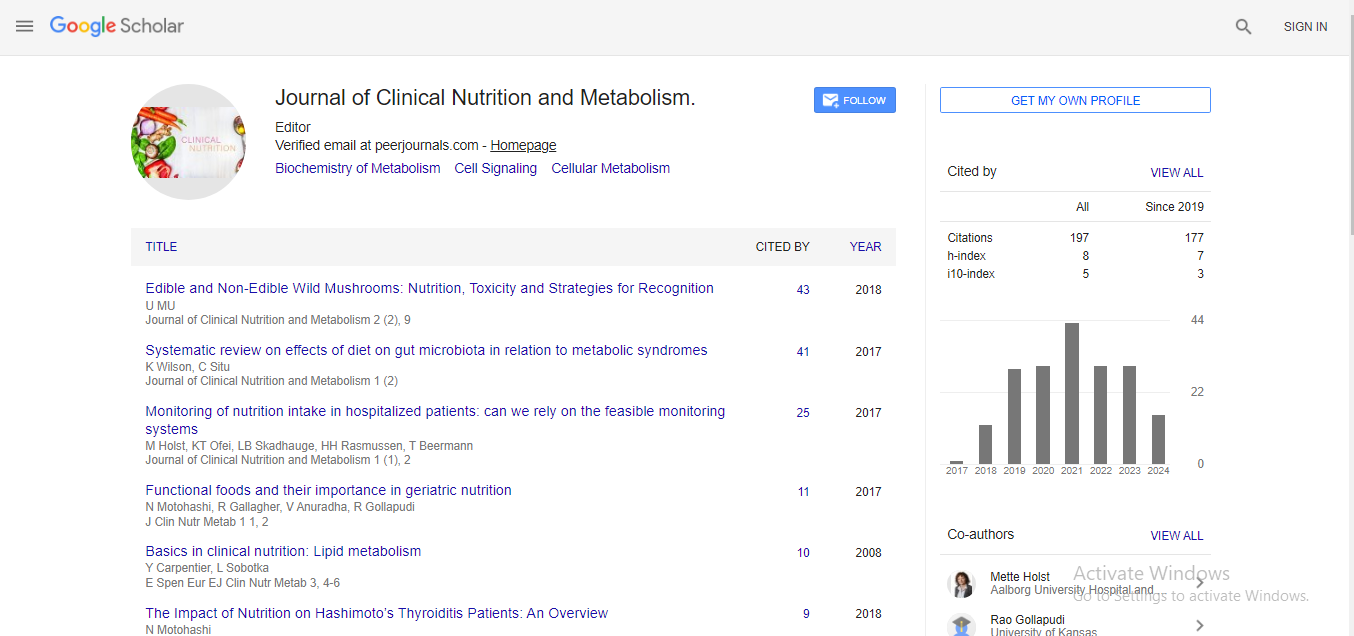Commentary, J Clin Nutr Metab Vol: 8 Issue: 1
Unraveling the Intricate Relationship: The Impact of Environmental Toxins on Metabolism
Partho Qadri*
1Department of Nutritional Sciences, Cornell University, Ithaca, New York, USA
*Corresponding Author: Partho Qadri,
Department of Nutritional Sciences,
Cornell University, Ithaca, New York, USA
E-mail: parthoq_2548@gmail.com
Received date: 26 February, 2024, Manuscript No. JCNM-24-137013;
Editor assigned date: 28 February, 2024, PreQC No. JCNM-24-137013 (PQ);
Reviewed date: 12 March, 2024, QC No. JCNM-24-137013;
Revised date: 20 March, 2024, Manuscript No. JCNM-24-137013 (R);
Published date: 26 March, 2024, DOI: 10.35841/jcnm.1000139
Citation: Qadri P (2024) Unraveling the Intricate Relationship: The Impact of Environmental Toxins on Metabolism. J Clin Nutr Metab 8:1.
Description
In our modern world, the ubiquity of environmental toxins poses a significant threat to human health. Beyond their direct effects on ecosystems, these toxins infiltrate our bodies, potentially wreaking havoc on various physiological processes. Among these, metabolism, the intricate web of biochemical reactions sustaining life, stands as a primary target. Understanding how environmental toxins perturb metabolism is import for devising effective strategies to mitigate their adverse effects and safeguard public health.
Environmental toxins encompass a broad spectrum, ranging from heavy metals and pesticides to air pollutants and industrial chemicals. These substances infiltrate our bodies through ingestion, inhalation, and dermal exposure, accumulating over time. Once inside, they disrupt metabolic pathways vital for energy production, nutrient utilization, and waste elimination. One prominent consequence of environmental toxin exposure is metabolic dysfunction. These toxins interfere with key metabolic processes, such as glucose and lipid metabolism, leading to conditions like insulin resistance, obesity, and dyslipidemia. For instance, Persistent Organic Pollutants (POPs), including dioxins and Polychlorinated Biphenyls (PCBs), disrupt insulin signaling pathways, contributing to insulin resistance-a precursor to type 2 diabetes.
Moreover, certain toxins mimic hormones, interfering with endocrine function and metabolic regulation. Bisphenol A (BPA), a common component of plastics, disrupts hormonal balance, potentially predisposing individuals to metabolic disorders. Similarly, phthalates, found in consumer products, exert estrogenic effects, altering metabolic homeostasis. Environmental toxins also influence the gut microbiota, the diverse community of microorganisms residing in our digestive tract. Disruption of this delicate ecosystem, termed dysbiosis, has profound implications for metabolism. Toxins like glyphosate, a ubiquitous herbicide, disrupt gut microbiota composition, promoting inflammation and metabolic derangement. Dysbiosis-induced metabolic disturbances contribute to obesity, insulin resistance, and fatty liver disease.
Another mechanism through which environmental toxins impact metabolism is epigenetic modification. These toxins alter gene expression patterns without modifying the underlying DNA sequence, influencing metabolic pathways across generations. Studies suggest that prenatal exposure to environmental toxins predisposes offspring to metabolic disorders later in life, highlighting the transgenerational impact of these pollutants. Mitochondria, the cellular powerhouses responsible for energy production, are particularly vulnerable to environmental toxins. Heavy metals like lead and mercury impair mitochondrial function, compromising ATP synthesis and cellular respiration. Mitochondrial dysfunction not only disrupts energy metabolism but also promotes oxidative stress, inflammation, and cell death-a recipe for metabolic catastrophe.
Environmental toxins unleash oxidative stress, an imbalance between pro-oxidant and antioxidant defenses, exacerbating metabolic dysfunction. Reactive Oxygen Species (ROS) generated by toxin exposure impair cellular structures and biomolecules, disrupting metabolic pathways. ROS-induced damage to lipids, proteins, and DNA perpetuates inflammation and insulin resistance, fueling the progression of metabolic disorders. Mitigating the impact of environmental toxins on metabolism necessitates a multifaceted approach. Regulation and enforcement of environmental policies are crucial for reducing toxin exposure at the source. Additionally, promoting lifestyle interventions, such as a healthy diet rich in antioxidants and regular physical activity, enhances metabolic resilience against environmental insults.
Furthermore, targeted therapies aimed at restoring mitochondrial function and mitigating oxidative stress show promise in ameliorating toxin-induced metabolic dysfunction. Strategies to restore gut microbiota balance, such as probiotics and prebiotics, offer another avenue for intervention.
Conclusion
The interplay between environmental toxins and metabolism underscores the complexity of human health. As we grapple with escalating environmental challenges, understanding the mechanisms underlying metabolic disruption is import. By unraveling this intricate relationship and implementing effective mitigation strategies, we can mitigate the adverse effects of environmental toxins and lead toward a healthier future.
 Spanish
Spanish  Chinese
Chinese  Russian
Russian  German
German  French
French  Japanese
Japanese  Portuguese
Portuguese  Hindi
Hindi 